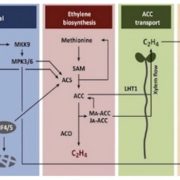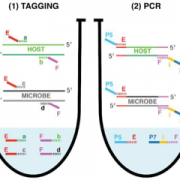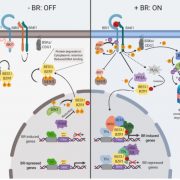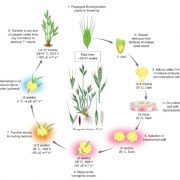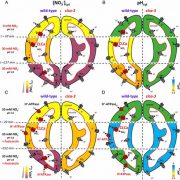Review: Harnessing synthetic chemistry to probe and hijack auxin signaling (New Phytol)
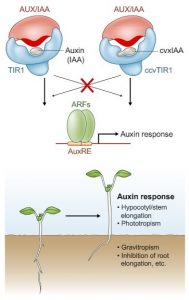 Auxin has been studied since Charles Darwin observed the phototropic response. More recently, chemical genetic approaches using auxin agonists and antagonists have been applied to studies of auxin. Torii et al. review how synthetic chemistry and chemical genetics have provided insights into and new tools for controlling auxin signaling. The authors briefly discuss synthetic auxins and auxinic herbicides (1-NAA, 2,4-D, 2,4,5-T, MCPB, picloram, triclopyr, dicamba, tricamba), as well as auxin antagonists (BH-IAA, PEO-IAA, auxinole). They also describe the recently published “bump and hole” approach, where auxin responses are controlled by the interaction between the inactive auxin analog, cvxIAA, which is recognized only by the engineered TIR1 receptor, ccvTIR1. In ccvTIR1, the 79th phenylalanine residue of TIR1 has been replaced with a glycine residue, rendering ccvTIR1 insensitive to the endogenous and synthetic auxins IAA, 1-NAA and 2,4-D. The synthesized auxin analog cvxIAA [5-(3-methylphenoxyl-IAA)] has reduced affinity for the natural receptor TIR1 and high affinity for the engineered receptor ccvTIR1. Overall, this review focuses on the powerful future application of engineered auxin receptors that can provide tissue-specific auxin responses to better understand auxin-mediated development. (Summary by Arif Ashraf) New Phytol. 10.1111/nph.15337
Auxin has been studied since Charles Darwin observed the phototropic response. More recently, chemical genetic approaches using auxin agonists and antagonists have been applied to studies of auxin. Torii et al. review how synthetic chemistry and chemical genetics have provided insights into and new tools for controlling auxin signaling. The authors briefly discuss synthetic auxins and auxinic herbicides (1-NAA, 2,4-D, 2,4,5-T, MCPB, picloram, triclopyr, dicamba, tricamba), as well as auxin antagonists (BH-IAA, PEO-IAA, auxinole). They also describe the recently published “bump and hole” approach, where auxin responses are controlled by the interaction between the inactive auxin analog, cvxIAA, which is recognized only by the engineered TIR1 receptor, ccvTIR1. In ccvTIR1, the 79th phenylalanine residue of TIR1 has been replaced with a glycine residue, rendering ccvTIR1 insensitive to the endogenous and synthetic auxins IAA, 1-NAA and 2,4-D. The synthesized auxin analog cvxIAA [5-(3-methylphenoxyl-IAA)] has reduced affinity for the natural receptor TIR1 and high affinity for the engineered receptor ccvTIR1. Overall, this review focuses on the powerful future application of engineered auxin receptors that can provide tissue-specific auxin responses to better understand auxin-mediated development. (Summary by Arif Ashraf) New Phytol. 10.1111/nph.15337



